 | ||
Similar Superoxide, Hydroxyl radical, Peroxynitrite | ||
Module 35 photoreduction and singlet oxygen photochemistry
Singlet oxygen is a high energy form of oxygen. A gas with the formula O2, its physical properties differ only subtly from those of the more prevalent triplet ground state of O2. In terms of its chemical reactivity, however, singlet oxygen is far more reactive toward organic compounds. It is responsible for the photodegradation of many materials but can be put to constructive use in preparative organic chemistry and photodynamic therapy. Trace amounts of singlet oxygen are found in the upper atmosphere and also in polluted urban atmospheres where it contributes to the formation of lung damaging nitrogen dioxide. It often appears and coexists confounded in environments that also generate ozone, such as pine forests with photodegradation of turpentine.
Contents
- Module 35 photoreduction and singlet oxygen photochemistry
- Mod 01 lec 20 singlet oxygen chemistry
- Electronic structure
- Paramagnetism due to orbital angular momentum
- Production
- Reactions
- Organic chemistry
- Biochemistry
- Analytical and physical chemistry
- References
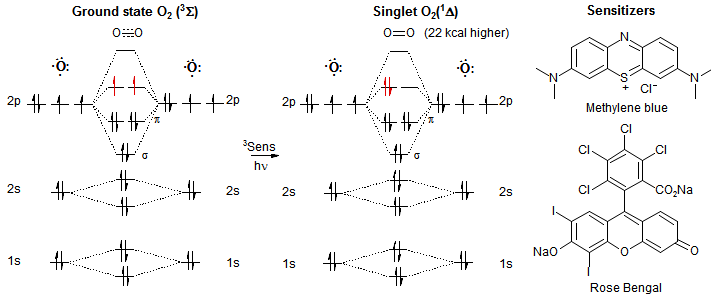
In spectroscopic notation, the singlet and triplet forms of O2 are labeled 1Δg and 3Σ−
g, respectively. The terms 'singlet oxygen' and 'triplet oxygen' refer to the quantum state of the molecules: singlet oxygen exists in the singlet state with a total quantum spin of 0, while triplet oxygen has a total quantum spin of 1.
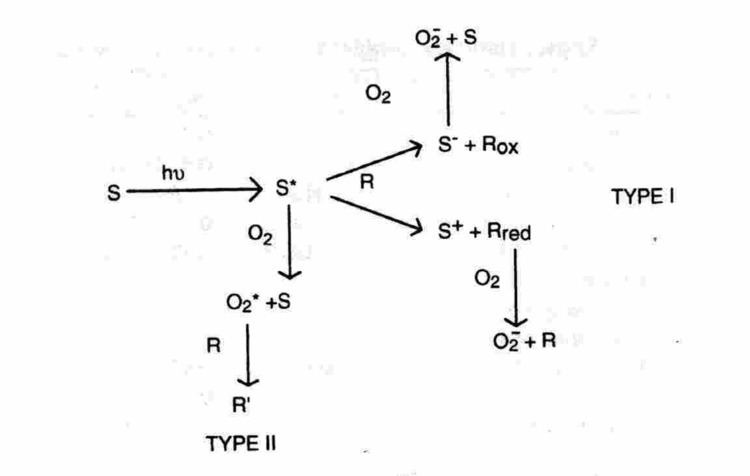
Mod 01 lec 20 singlet oxygen chemistry
Electronic structure
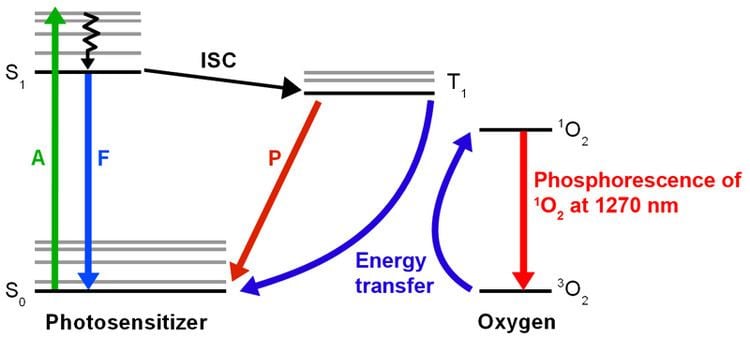
Singlet oxygen refers to one of two singlet electronic excited states. The two singlet states are denoted 1Σ+
g and 1Δg (the preceding superscripted "1" indicates it as a singlet state). The singlet states of oxygen are 158 and 95 kilojoules per mole higher in energy than the triplet ground state of oxygen. Under most common laboratory conditions, the higher energy 1Σ+
g singlet state rapidly converts to the more stable, lower energy 1Δg singlet state; it is this, the more stable of the two excited states, the one with its electrons remaining in separate degenerate orbital but no longer with like spin, that is referred to by the title term, singlet oxygen, commonly abbreviated 1O2, to distinguish it from the triplet ground state molecule, 3O2.
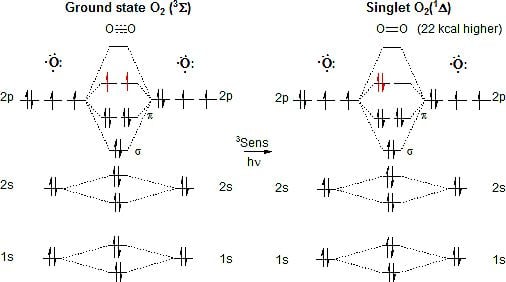
Molecular orbital theory predicts two low-lying excited singlet states, denoted by the molecular term symbols 1Δg and 1Σ+
g. These electronic states differ only in the spin and the occupancy of oxygen's two antibonding πg-orbitals, which are degenerate (equal in energy). Following Hund's first rule, these electrons are unpaired. These two orbitals are classified as antibonding and are of higher energy; the electrons occupying them have like (same) spin, and this ground state is represented, as noted, by the term symbol 3Σ−
g.
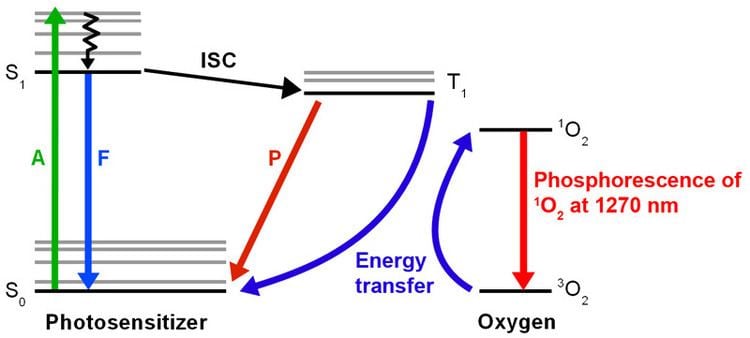
Two less stable, higher energy excited states are readily accessible from this ground state, again in accordance with Hund's first rule; the first moves one of the high energy unpaired ground state electrons from one degenerate orbital to the other, where it "flips" and pairs the other, and creates a new state, a singlet state referred to as the 1Δg state (a term symbol, where the preceding superscripted "1" indicates it as a singlet state). Alternatively, both electrons can remain in their degenerate ground state orbitals, but the spin of one can "flip" so that it is now opposite to the second (i.e., it is still in a separate degenerate orbital, but no longer of like spin); this also creates a new state, a singlet state referred to as the 1Σ+
g state. The ground and first two singlet excited states of oxygen can be described by the simple scheme in the figure below.

The 1Δg singlet state is 7882.4 cm−1 above the triplet 3Σ−
g ground state., which in other units corresponds to 94.29 kJ/mol or 0.9773 eV. The 1Σ+
g singlet is 13 120.9 cm−1 (157.0 kJ/mol or 1.6268 eV) above the ground state. The open-shell triplet ground state of molecular oxygen differs from most stable diatomic molecules, which have singlet (1Σ+
g) ground states.
The 1Σ+
g state is very short lived and relaxes quickly to the lowest lying 1Δg excited state; it is this lower, O2(1Δg) state that is commonly referred to as singlet oxygen. The energy difference between ground state and singlet oxygen referred to above (e.g., 94.3 kJ/mol) corresponds to a transition in the near-infrared at ~1270 nm. This transition is strictly forbidden by spin, symmetry, and parity selection rules; hence, direct excitation of ground state oxygen by light to form singlet oxygen is very improbable. As a consequence, singlet oxygen in the gas phase is extremely long lived (72 minutes), although interaction with solvents reduces the lifetime to microseconds or even nanoseconds.
Paramagnetism due to orbital angular momentum
Singlet oxygen has no unpaired electrons and therefore no net electron spin. The 1Δg is however paramagnetic as shown by the observation of an electron paramagnetic resonance (EPR) spectrum. The paramagnetism is due to a net orbital (and not spin) electronic angular momentum. In a magnetic field the degeneracy of the π* level is split into two levels corresponding to molecular orbitals with angular momenta +1ħ and −1ħ around the molecular axis. In the 1Δg state one of these orbitals is doubly occupied and the other empty, so that transitions are possible between the two.
Production
Various methods for the production of singlet oxygen exist. Irradiation of oxygen gas in the presence of an organic dye as a sensitizer, such as rose bengal, methylene blue, or porphyrins—a photochemical method—results in its production. Singlet oxygen can also be in non-photochemical, preparative chemical procedures. One chemical method involves the decomposition of triethylsilyl hydrotrioxide generated in situ from triethylsilane and ozone.
(C2H5)3SiH + O3 → (C2H5)3SiOOOH → (C2H5)3SiOH + O2(1Δg)Another method uses the aqueous reaction of hydrogen peroxide with sodium hypochlorite:
H2O2 + NaOCl → O2(1Δg) + NaCl + H2OA third method liberates singlet oxygen via phosphite ozonides, which are, in turn, generated in situ. Phosphite ozonides will decompose to give singlet oxygen:
(RO)3P + O3 → (RO)3PO3(RO)3PO3 → (RO)3PO + O2(1Δg)An advantage of this method is that it is amenable to non-aqueous conditions.
Reactions
Because of differences in their electron shells, singlet and triplet oxygen differ in their chemical properties, singlet oxygen is highly reactive. The lifetime of singlet oxygen depends on the medium. In normal organic solvents, the lifetime is only a few microseconds whereas in solvents lacking C-H bonds, the lifetime can be as long as seconds.
Organic chemistry
Unlike ground state oxygen, singlet oxygen participates in Diels–Alder [4+2]- and [2+2]-cycloaddition reactions and formal concerted ene reactions. It oxidizes thioethers to sulfoxides and organometallic complexes. With some substrates 1,2-dioxetanes are formed; cyclic dienes such as 1,3-cyclohexadiene form [4+2] cycloaddition adducts.
In singlet oxygen reactions with alkenic allyl groups, e.g., citronella, shown, by abstraction of the allylic proton, in an ene-like reaction, yielding the allyl hydroperoxide, R–O–OH (R = alkyl), which can then be reduced to the corresponding allylic alcohol.
In reactions with water trioxidane, an unusual molecule with three consecutive linked oxygen atoms, is formed.
Biochemistry
In photosynthesis, singlet oxygen can be produced from the light-harvesting chlorophyll molecules. One of the roles of carotenoids in photosynthetic systems is to prevent damage caused by produced singlet oxygen by either removing excess light energy from chlorophyll molecules or quenching the singlet oxygen molecules directly.
In mammalian biology, singlet oxygen is one of the reactive oxygen species, which is linked to oxidation of LDL cholesterol and resultant cardiovascular effects. Polyphenol antioxidants can scavenge and reduce concentrations of reactive oxygen species and may prevent such deleterious oxidative effects.
Ingestion of pigments capable of producing singlet oxygen with activation by light can produce severe photosensitivity of skin (see phototoxicity, photosensitivity in humans, photodermatitis, phytophotodermatitis). This is especially a concern in herbivorous animals (see Photosensitivity in animals).
Singlet oxygen is the active species in photodynamic therapy.
Analytical and physical chemistry
Direct detection of singlet oxygen is possible using sensitive laser spectroscopy or through its extremely weak phosphorescence at 1270 nm, which is not visible. However, at high singlet oxygen concentrations, the fluorescence of the singlet oxygen "dimol" species—simultaneous emission from two singlet oxygen molecules upon collision—can be observed as a red glow at 634 nm.
